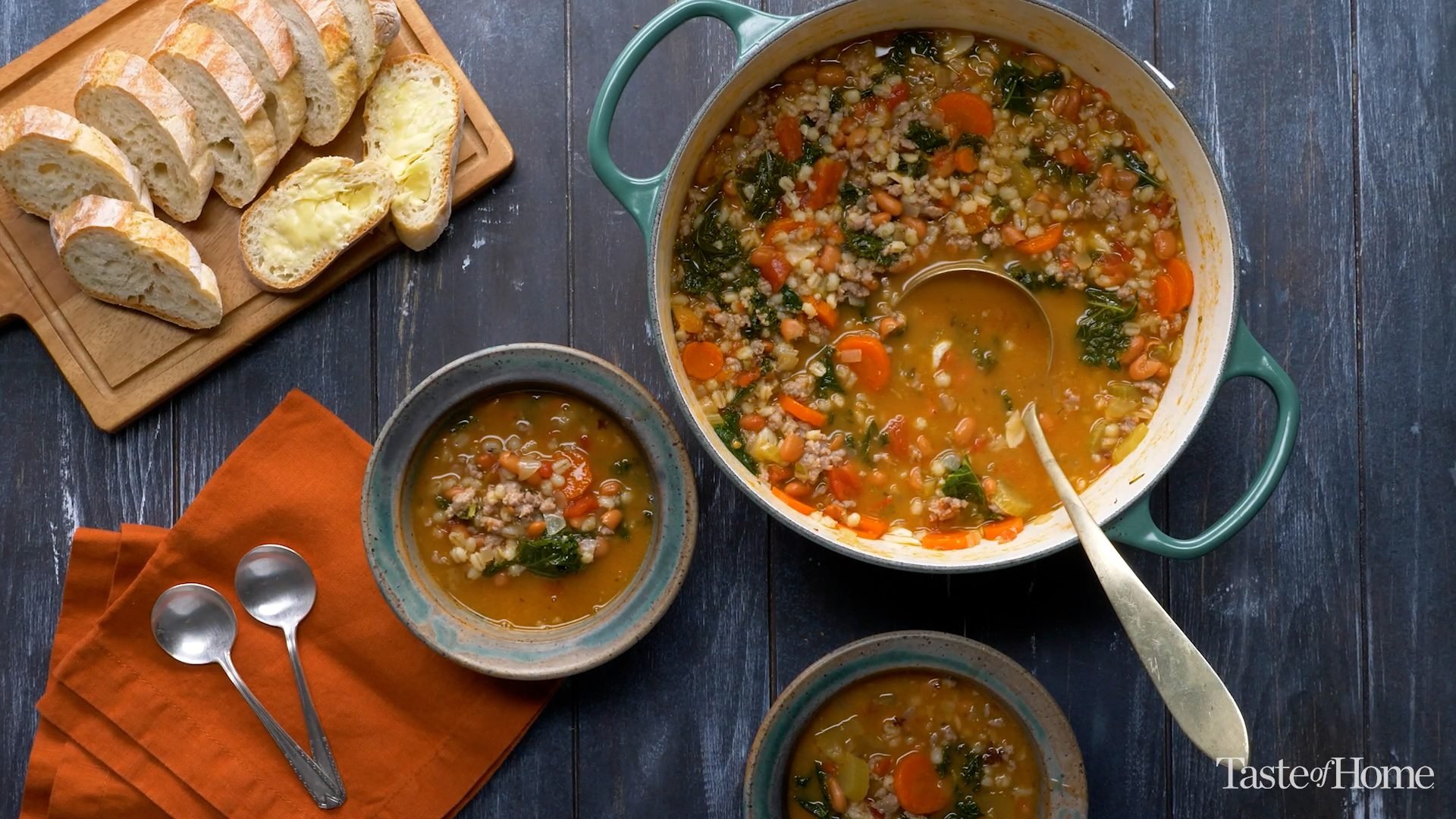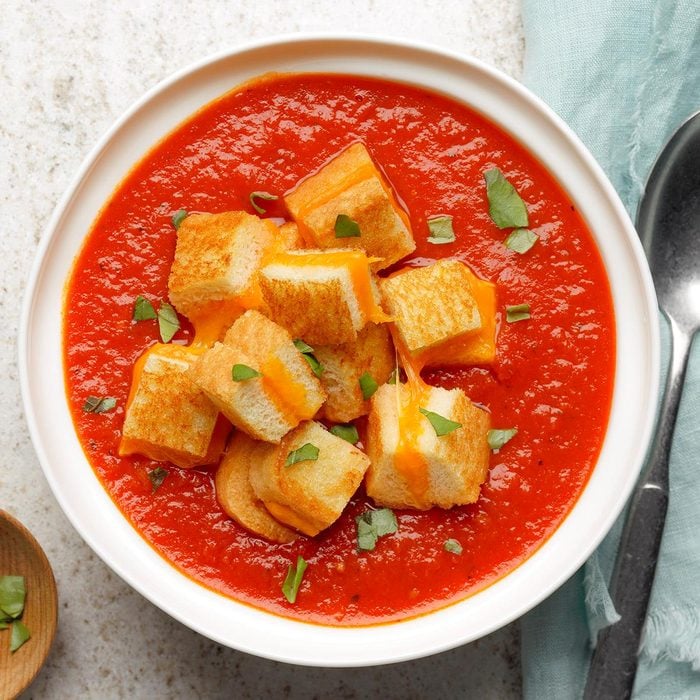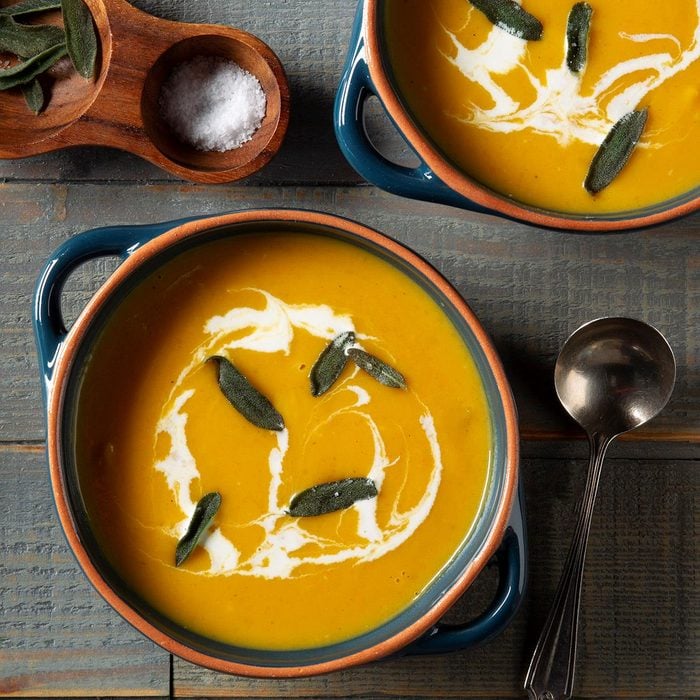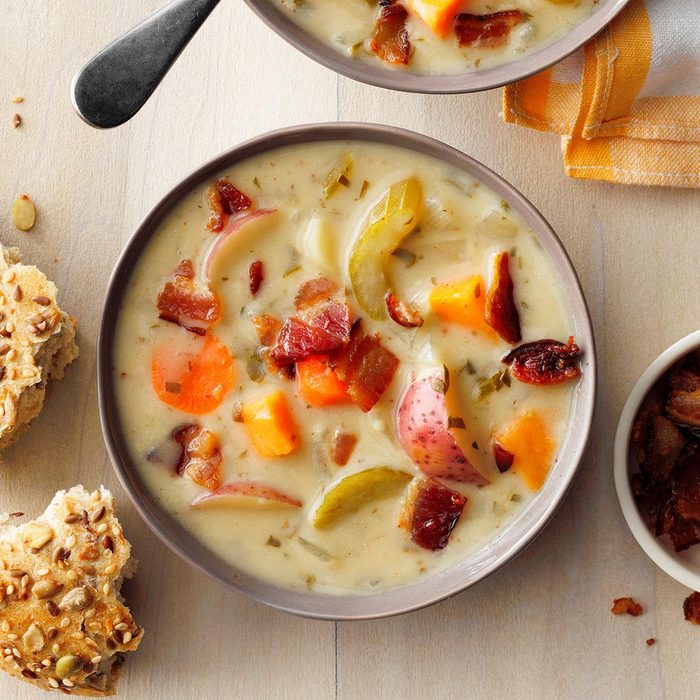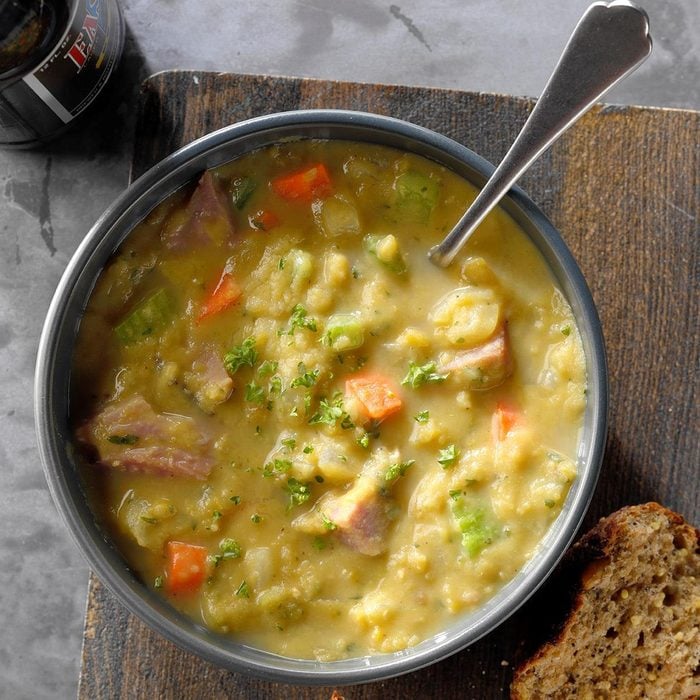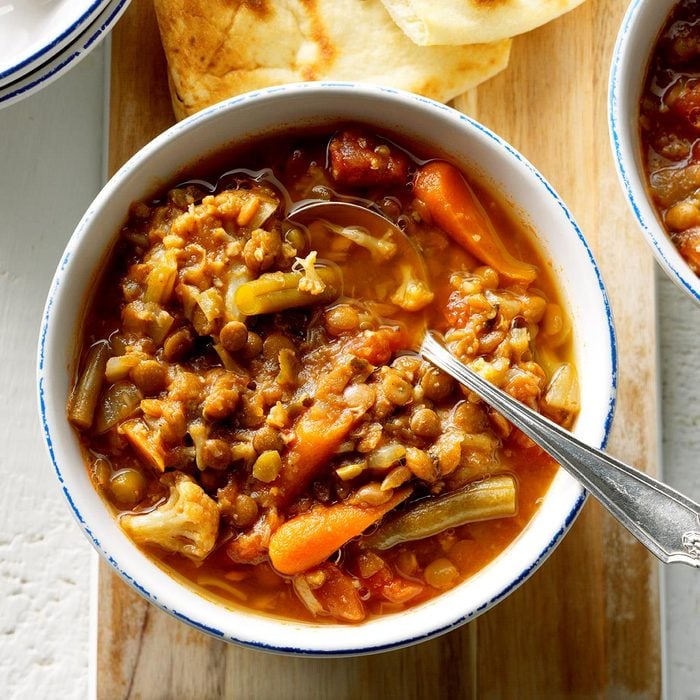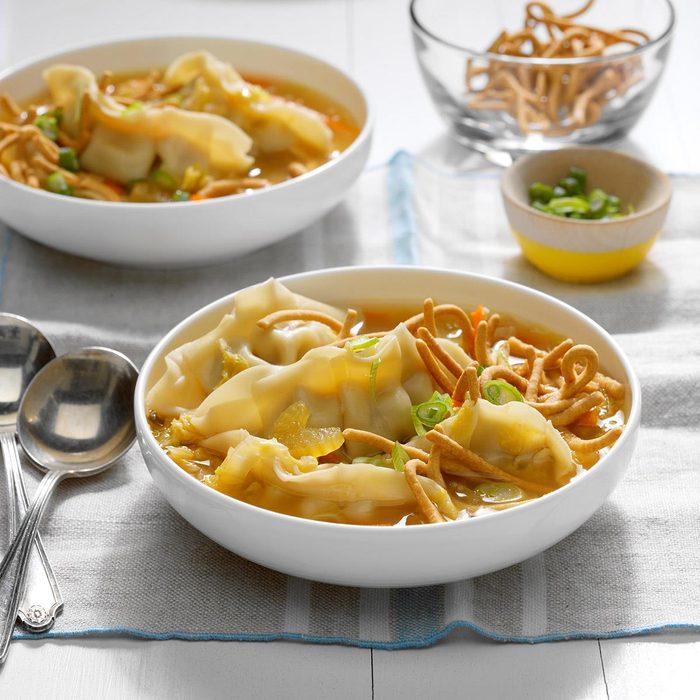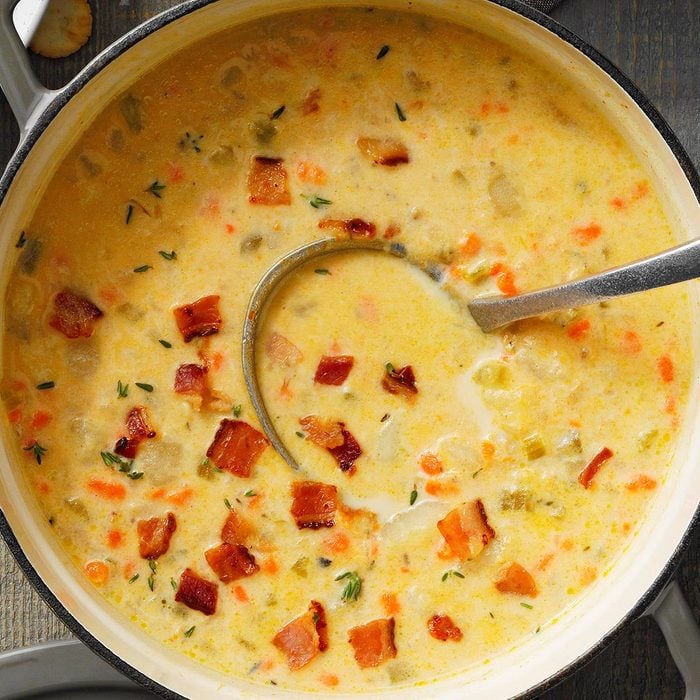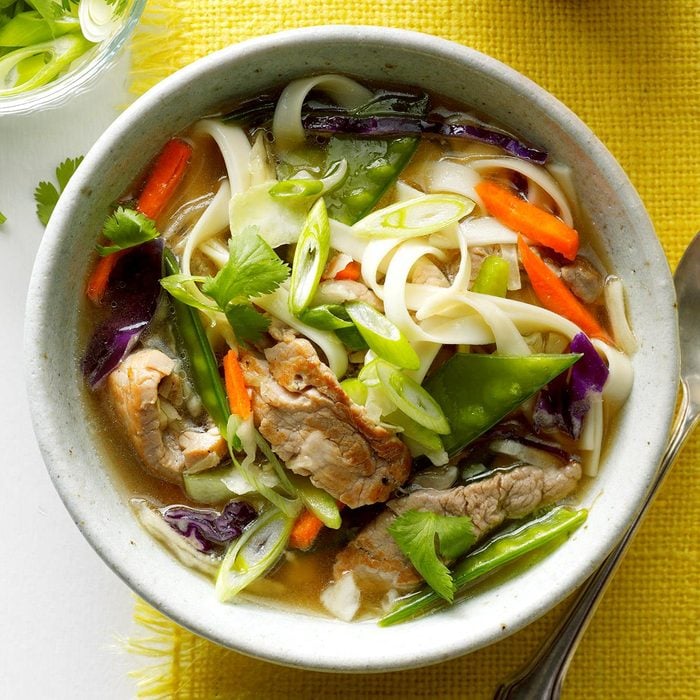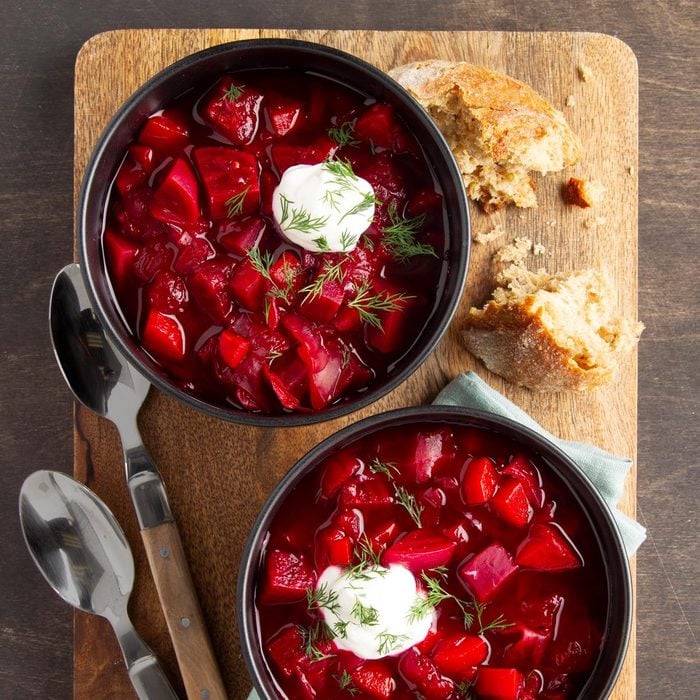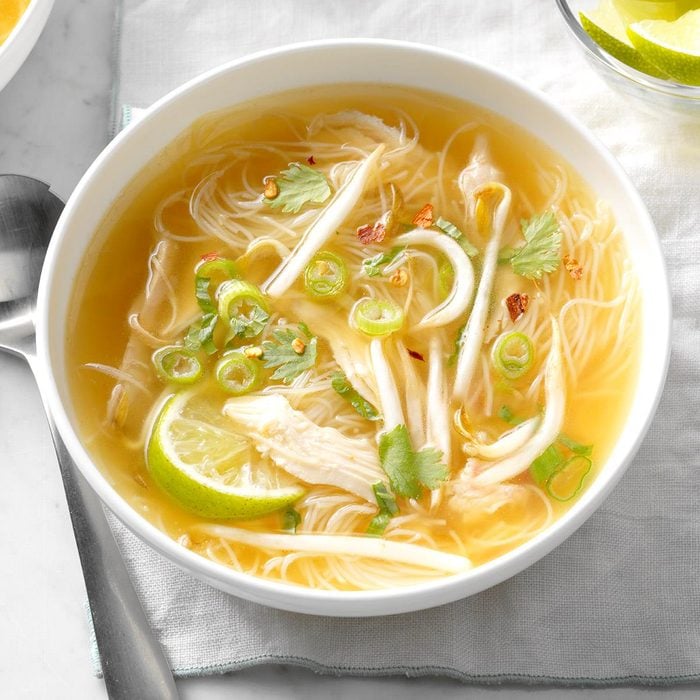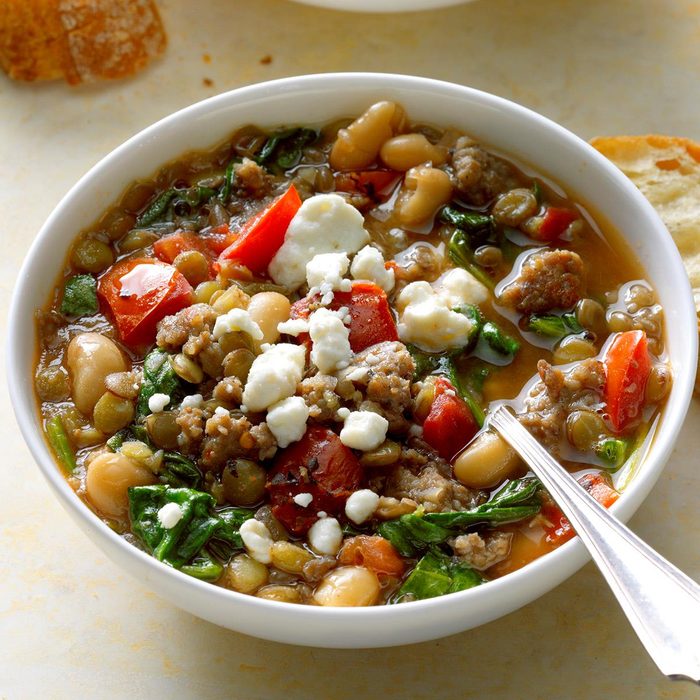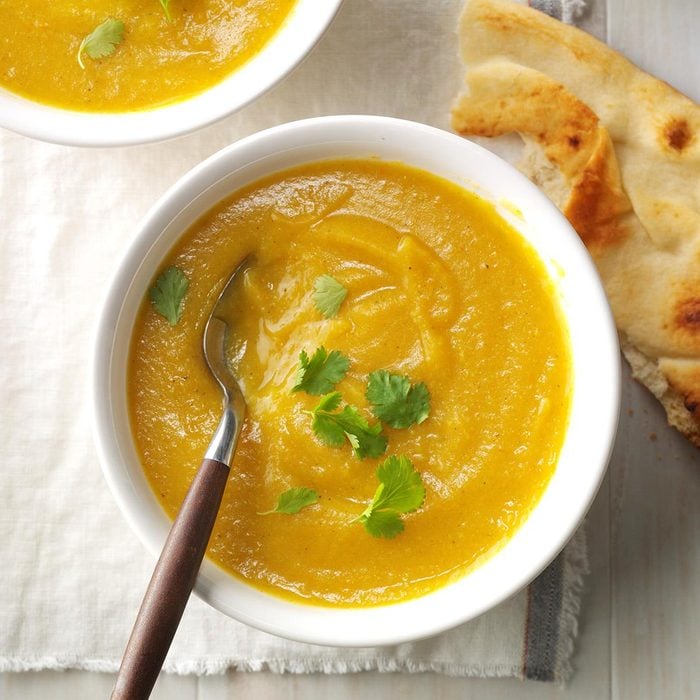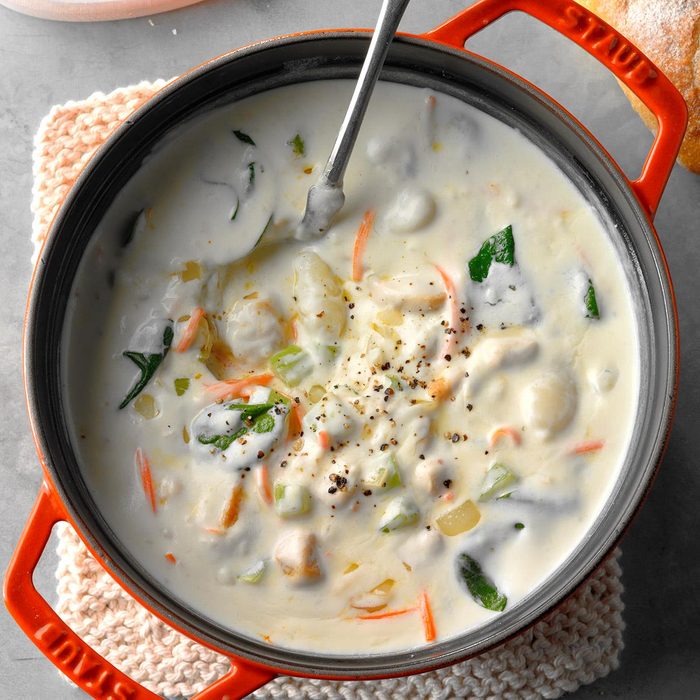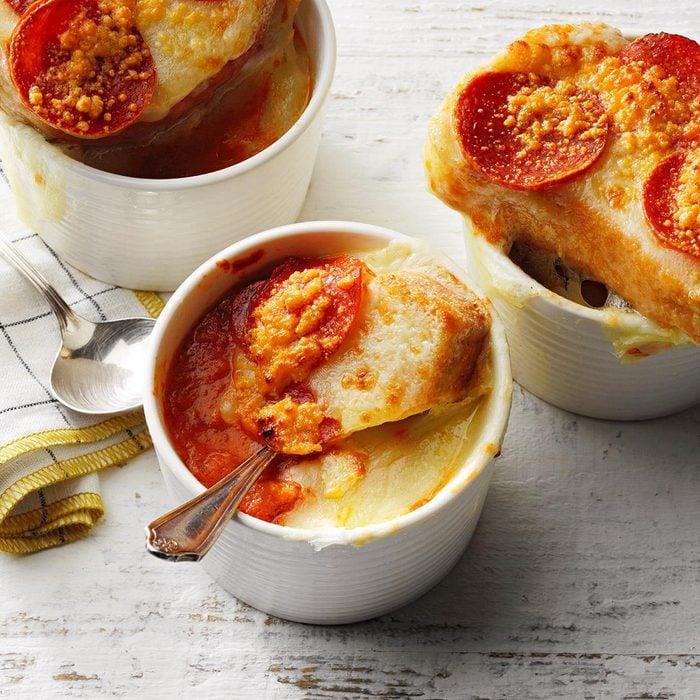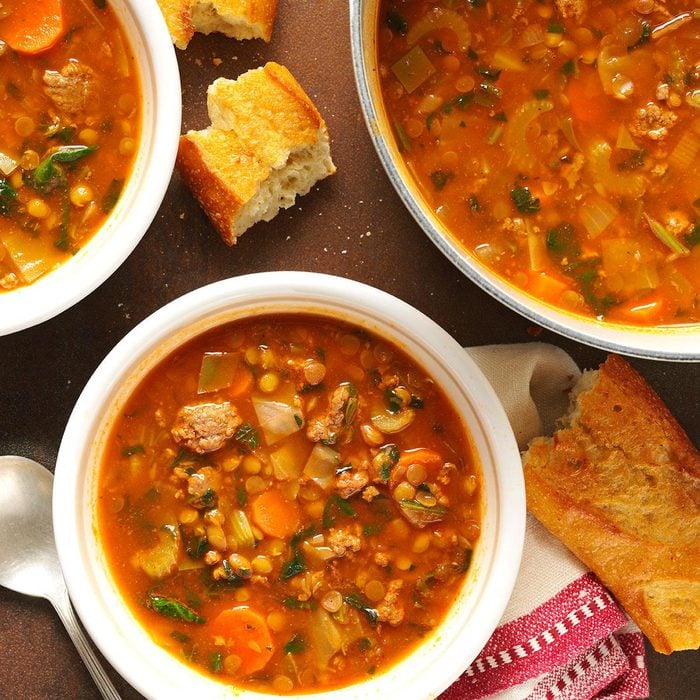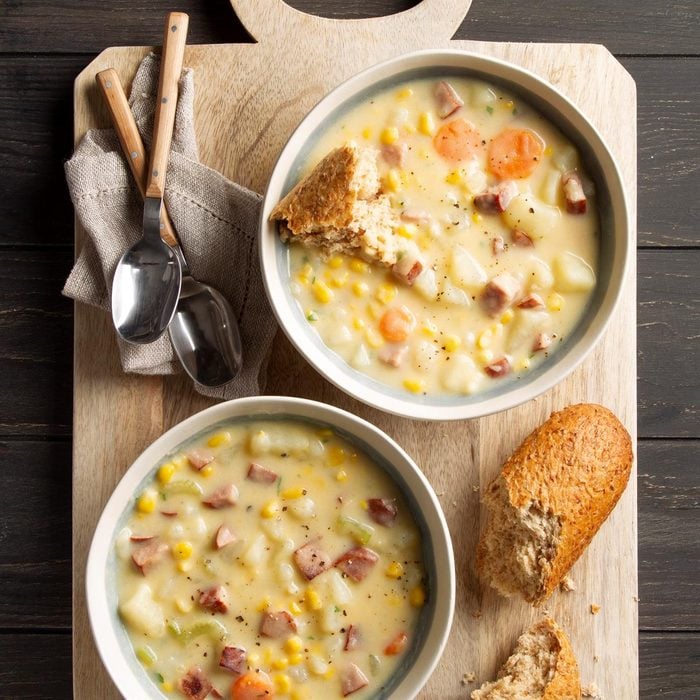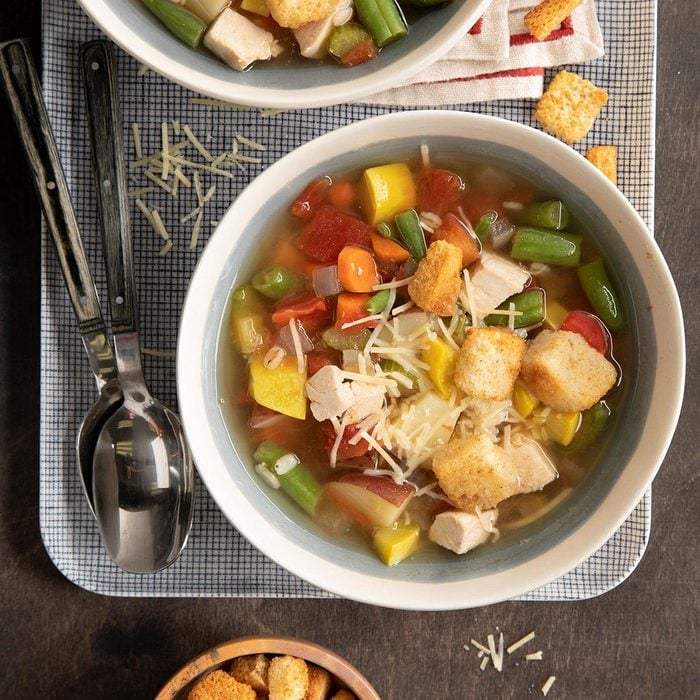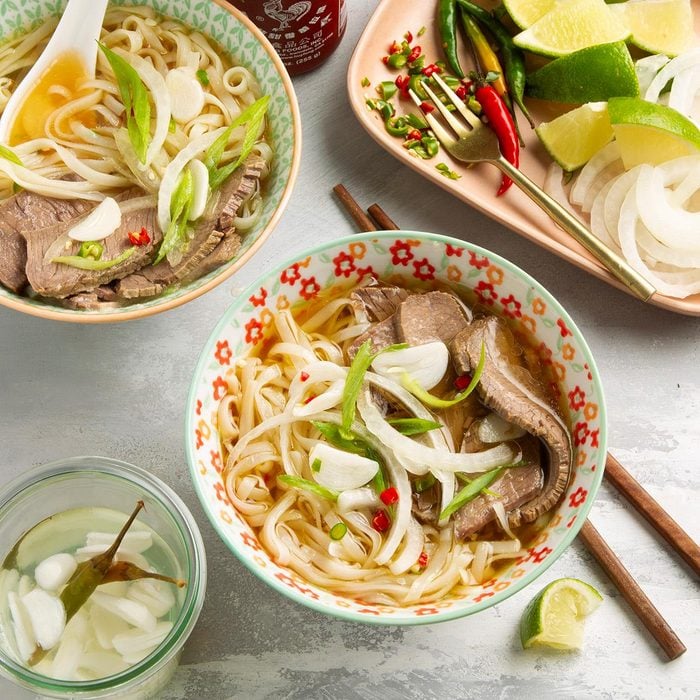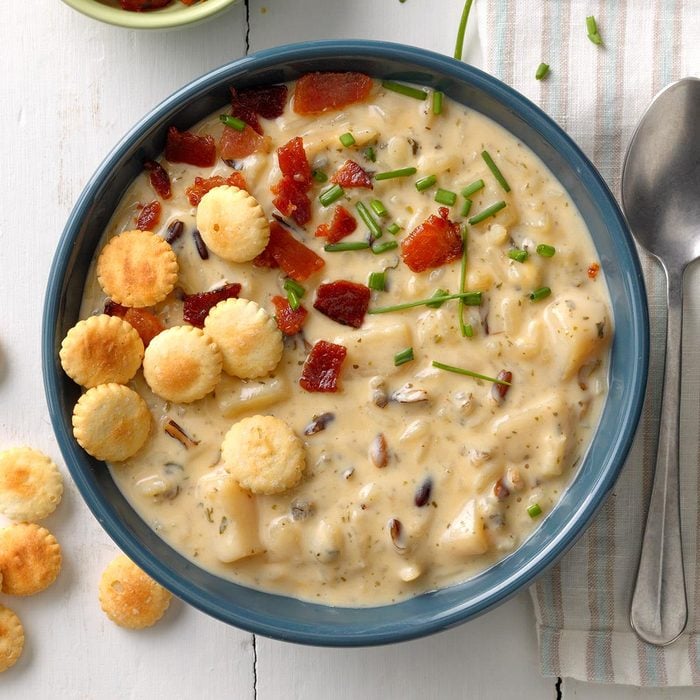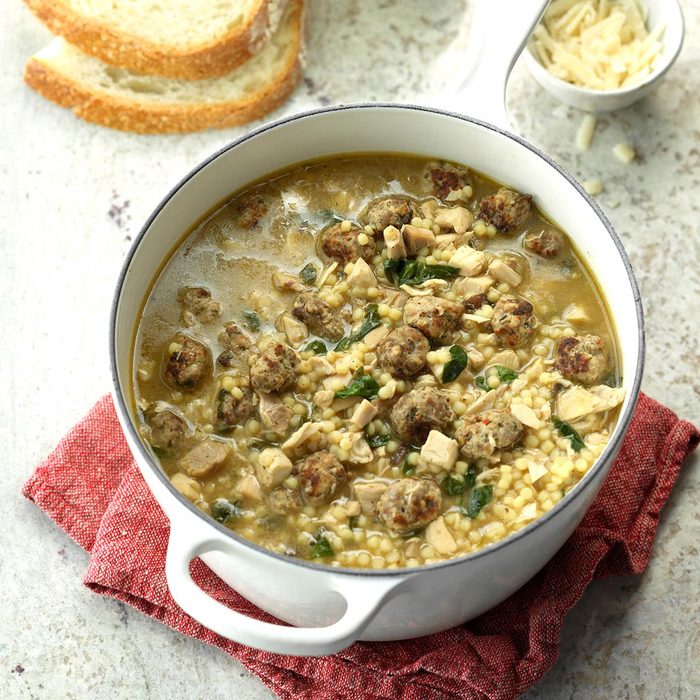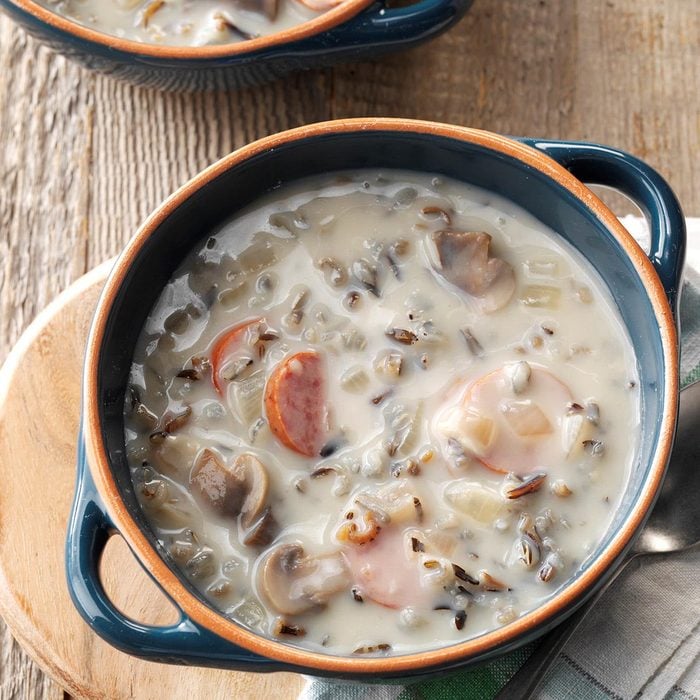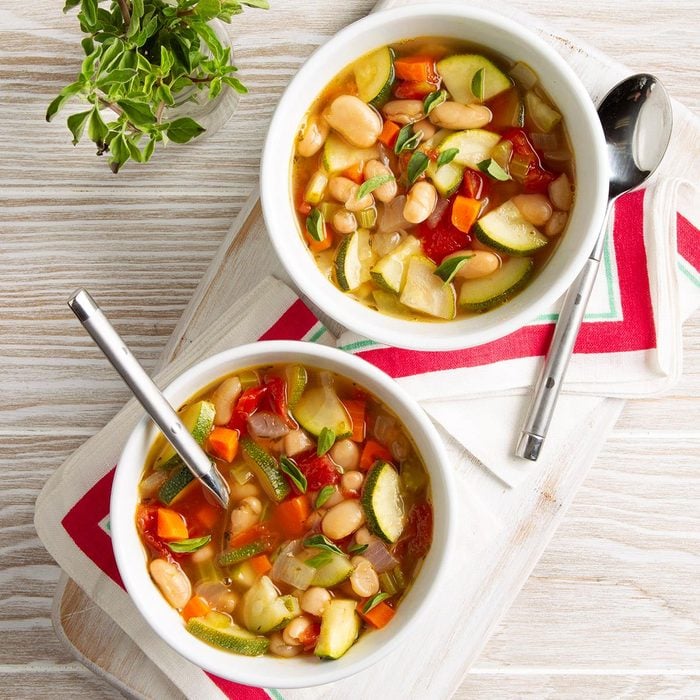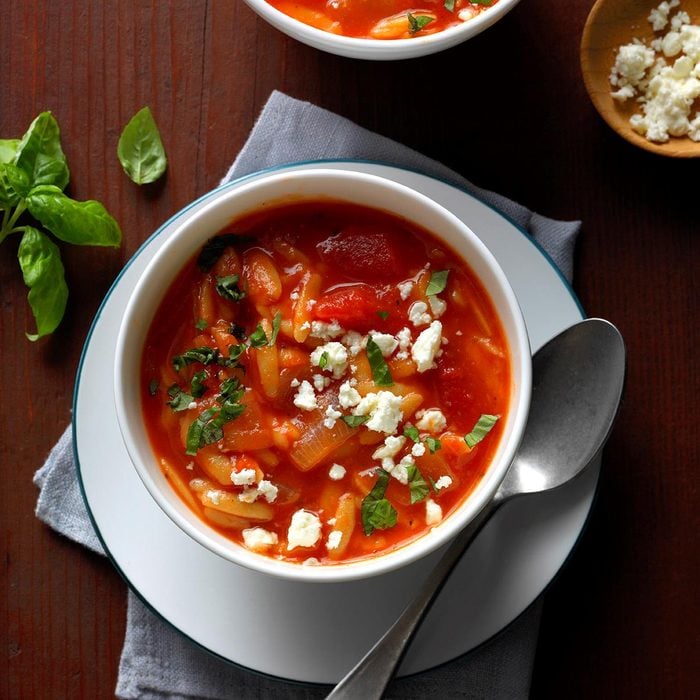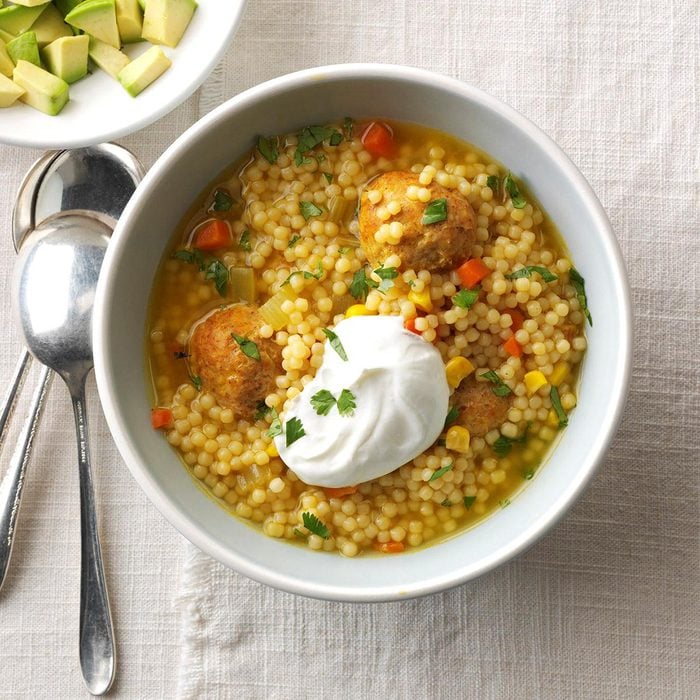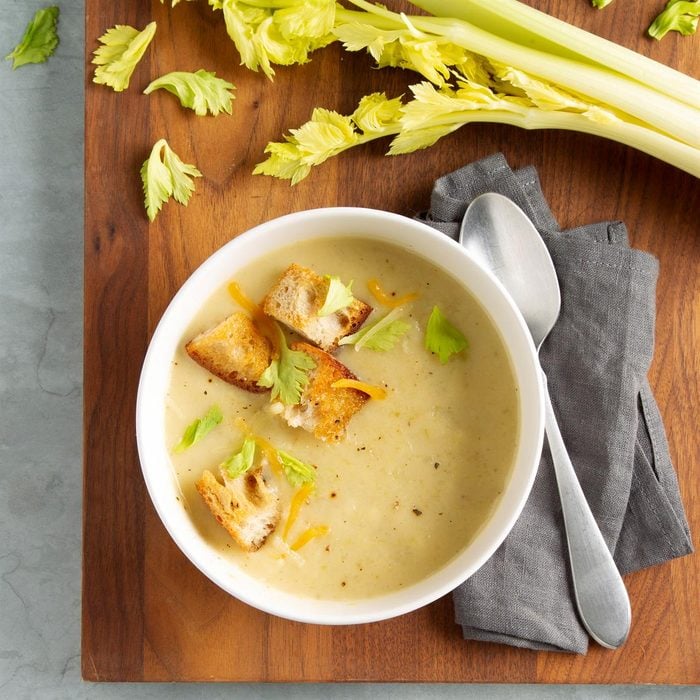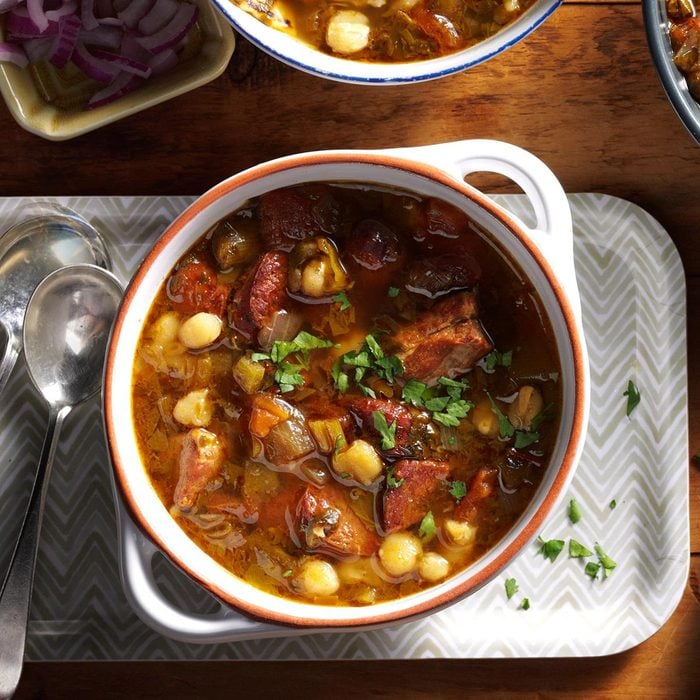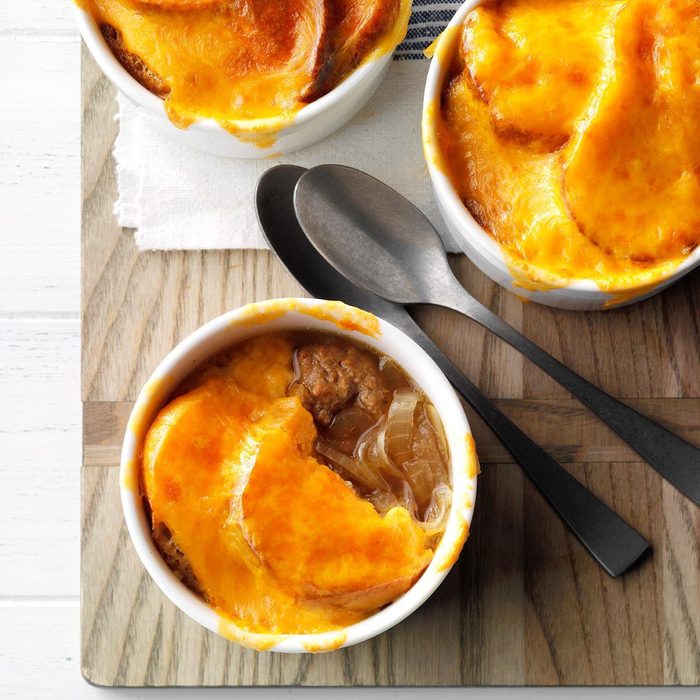Italian Sausage Bean Soup
In the cold months, I like to put on a big pot of this comforting soup. It cooks away while I do other things, such as baking bread, crafting or even cleaning the house. —Glenna Reimer, Gig Harbor, Washington
Go to Recipe
Instant Pot Potato SoupI decided to add some character to a basic potato chowder with roasted red peppers. The extra flavor gives a deliciously unique twist to an otherwise ordinary soup.—Mary Shivers, Ada, Oklahoma
Satisfying Tomato SoupAfter craving tomato soup, I decided to make my own. My sister Joan likes it chunky-style, so she doesn't puree. Serve it with a grilled cheese sandwich. —Marian Brown, Mississauga, Ontario
Classic French Onion SoupEnjoy my signature French onion soup the way my granddaughter Becky does: I make onion soup for her in a crock bowl, complete with garlic croutons and gobs of melted Swiss cheese on top. —Lou Sansevero, Ferron, Utah
Cheddar Broccoli SoupFrozen broccoli speeds preparation of this warm and satisfying soup. —Louise Beatty, Amherst, New York
Hearty Homemade Chicken Noodle SoupI'm not sure any other
old fashioned soup recipes can compare with this! This satisfying soup with a hint of cayenne is brimming with vegetables, chicken and noodles. The recipe is from my father-in-law, but I tweaked it to make it my own. —Norma Reynolds, Overland Park, Kansas
Easy Butternut Squash SoupWhen the weather turns cold, get cozy with a bowl of this butternut squash soup. This recipe is super easy. The cream adds richness, but if you're looking to cut calories, it can be omitted. —Taste of Home Test Kitchen, Milwaukee, Wisconsin
Creamy Vegetable ChowderThis rich, comforting soup recipe can easily be doubled or tripled. You can lower the fat content by using turkey bacon, vegetable broth and skim milk. It's delicious either way. —Suzanna VandeBrake, Peyton, Colorado
Pressure-Cooker English Pub Split Pea SoupThis family favorite is the same recipe my grandmother used. Now with the magic of today's appliances, I can spend 15 minutes putting it together, walk away for a bit and then it's "soup's on!" Finish it with more milk if you like your split pea soup a bit thinner. —Judy Batson, Tampa, Florida
Spicy Veggie & Lentil SoupI enjoy this recipe because it’s
meatless, inexpensive and simply delicious! You can substitute any vegetables you like—it’s all a matter of preference. Serve warm
pita bread on the side. —Geraldine Hennessey, Glendale, New York
Potsticker SoupSince my husband and I have
soup often, I’m always coming up with something new. I saw
potstickers in the freezer and decided to feature them in Asian soup. The results were delicious. Rice vinegar provides just the right tang, and the green onions and carrots add color. Stir in chopped cabbage or bok choy if you like. A little sesame oil goes a long way, but you can always add a bit more. —Darlene Brenden, Salem, Oregon
Golden Clam ChowderThis is one of the
best soup recipes! Yes, you can have a warm bowl of homemade clam chowder for dinner tonight or any night. The soup is seasoned expertly and thyme adds a great dimension of flavor. —Amanda Bowyer, Caldwell, Idaho
Asian Long Noodle SoupThis flavorful soup is perfect for when you want something warm and filling in a hurry. If you can't find long noodles, angel hair pasta is a good substitute. —Carol Emerson, Aransas Pass, Texas
Borscht SoupWith beets, carrots, cabbage and tomatoes, this Russian borscht soup recipe is great for gardeners like myself. Not only is it delicious, but its bright crimson color is eye-catching on the table. —Ginny Bettis, Montello, Wisconsin
Spinach and Tortellini SoupA simple tomato-enhanced broth is perfect for cheese tortellini and fresh spinach. Increase the garlic and add Italian seasoning to suit your taste. —Debbie Wilson, Burlington, North Carolina
Grandma’s Chicken ‘n’ Dumpling SoupI've enjoyed making this rich homemade chicken dumpling soup recipe for more than 40 years. Every time I serve it, I remember my southern grandma, who was very special to me and was known as an outstanding cook. —Paulette Balda, Prophetstown, Illinois
Thai Chicken Noodle SoupThis slow cooker soup is a semi-homemade version that coaxes all of the flavor out of a
rotisserie chicken. Do the prep work the day before and toss the broth-making ingredients into the slow cooker in the morning. It's a snap to finish when you get home. —Beth Jacobson, Milwaukee, Wisconsin
Spinach and Sausage Lentil SoupDuring the cooler months of the year, this soup makes regular appearances on our dinner table. This is one of those winter soup recipes that's approved by all, including my picky 6-year-old. —Kalyn Gensic, Ardmore, Oklahoma
Dill Chicken SoupI could eat soup for every meal of the day, all year long. I particularly like dill and spinach—they add a brightness to this light and healthy soup. —Robin Haas, Jamaica Plain, Massachusetts
Creamy Cauliflower Pakora SoupMy husband and I often crave pakoras, deep-fried fritters from India. I wanted to get the same flavors but use a healthier cooking technique, so I made soup using all the classic spices and our favorite veggie,
cauliflower! —Melody Johnson, DePere, Wisconsin
Spicy Montana ChiliThis thick and chunky chili has some kick to it. I like to top it with shredded cheddar and then serve it with a side of cornbread. —Donna Evaro, Casper, Wyoming
Creamy Chicken Gnocchi SoupI tasted a similar soup at
Olive Garden and wanted to try and make it myself. Here's the delicious result! It's wonderful on a cool evening. —Jaclynn Robinson, Shingletown, California
Creamy Pizza SoupThis Creamy Pizza Soup is like eating supreme pizza with a spoon! You can add your own favorite pizza toppings as long as you include the ooey-gooey melty cheese on top. If you can't find the tomato and sweet basil bisque soup, try using canned tomato bisque soup and adding Italian seasoning. —Susan Bickta, Kutztown, Pennsylvania
Want more warm, hearty soup ideas? Check out these
slow cooker chili recipes.
Beef Lentil SoupYou can prepare this soup as the main course in a hearty lunch or dinner. On cold winter evenings here in New England, I've often enjoyed sipping a steaming mugful in front of our fireplacel. —Guy Turnbull, Arlington, Massachusetts
Broccoli Beer Cheese SoupWhether you include the beer or not, this soup tastes wonderful. I always make extra and pop single servings into the freezer. —Lori Lee, Brooksville, Florida
Sausage Potato SoupI rely on this thick, chunky Sausage Potato Soup on busy weeknights when I'm too tired to spend a lot of time preparing dinner. The whole family enjoys the wonderful flavor of the smoked sausage. —Jennifer LeFevre, Hesston, Kansas. Make sure you try this
old-fashioned potato soup recipe.
Stone Soup RecipeAfter reading the Stone Soup story, our Test Kitchen enjoyed concocting this version of the folktale classic. It’s chock-full of veggies and lots more ingredients…enough for everyone to bring something to add to the fun and flavor!
Slow-Cooker Corn ChowderI combine and refrigerate the ingredients for this slow-cooker corn chowder the night before. In the morning, I pour the mixture into my crock and turn it on. When I come home from work, a hot, tasty meal awaits. —Mary Hogue, Rochester, Pennsylvania
Best Lasagna SoupAll the traditional flavors of lasagna come together in this heartwarming bowl of comfort. —Sheryl Olenick, Demarest, New Jersey
Want to try a popular variation of this cozy dish? Try this viral
lasagna soup recipe.
Mexican Chicken Corn ChowderI like to make this smooth, creamy soup when company comes to visit. Its zippy flavor is full of southwestern flair. My family enjoys dipping slices of homemade bread in this chowder to soak up every bite! —Susan Garoutte, Georgetown, Texas
Pho (Vietnamese Noodle Soup)Pho is one of Vietnam's most well-known dishes. For many families, the cooking of the dish is a true labor of love and care. With its aromatic broth, slurpable rice noodles and many delicious garnish options, it is very easy to customize a bowl to suit your tastes. —
Taste of Home Test Kitchen
Lobster BisqueMy grandmother would make lobster bisque all the time, so I've always thought of it as comfort food. If you don't care to cook live lobsters, they can usually be cooked where you buy them. Just be sure to say that you want to keep the shells; they are the key to the most delicious soup! —James Schend,
Taste of Home Deputy Editor
Cheesy Wild Rice SoupWe often eat easy-to-make winter soup recipes when there’s not a lot of time to cook. I replaced the wild rice in the original recipe with a boxed rice mix. This creamy concoction is now a favorite.
Traditional Italian Wedding SoupYou don’t have to be Italian to love this easy-to-make soup with tiny round pasta! Add homemade meatballs but use ready-made stock and rotisserie chicken.—Mary Sheetz, Carmel, Indiana
Simple Salmon ChowderI've lived on a farm in the Yakima Valley all my life. I have a big garden, and by the end of fall, my cellar shelves are full of canned fruits and vegetables. This salmon chowder recipe uses some of the root vegetables I grow—along with the delicious salmon that is so plentiful here. —Josephine Parton, Granger, Washington
Mexican-Inspired Chicken SoupThis zesty chicken taco soup is loaded with corn and black beans in a mildly spicy red broth. As a busy mom of three young children, I'm always looking for dinner recipes that can be prepared in the morning. The kids love the taste of this easy soup. —Marlene Kane, Lainesburg, Michigan
Wild Rice Mushroom SoupI think mushrooms often get used only as a seasoning or added flavor, but I think they are delicious enough to be the main part of a meal. This recipe uses a large quantity of mushrooms and the result is delicious. Even though this contains some dairy,
this soup freezes quite well! —Wendy Campbell, New Wilmington, Pennsylvania
Vegetarian White Bean SoupThe home economists in our Test Kitchen simmered up this fresh-tasting meatless soup. Hearty with two kinds of beans, it makes a satisfying entree. Round out the meal with Walnut Zucchini Muffins or warm dinner rolls.
Salmon Dill SoupThis is the best soup I have ever made, according to my husband, who loves salmon so much that he could eat it every day. It's a treat for both of us, so when I get some, I try to make it a very special dish like this one. —Hidemi Walsh, Plainfield, Indiana
Greek Tomato Soup with OrzoMy recipe for manestra, which means orzo in Greek, is effortless and very easy to make. You need only a few steps to transform simple ingredients into a creamy one-pot wonder. —Kiki Vagianos, Melrose, Massachusetts
Southwest-Style Wedding SoupI turned leftover
ground chicken into meatballs and dreamed up this cozy southwestern soup. Now my Italian family asks for it over traditional wedding soup. —Teena Petrus, Johnstown, Pennsylvania
Ground Turkey Vegetable SoupLow-sodium ingredients don't diminish the full flavor of this brothy ground turkey vegetable soup. The turkey lends a heartiness that everyone will welcome on a cold blustery evening. —Bonnie LeBarron, Forestville, New York
Cream of Celery Soup RecipeThis rich cream of celery soup recipe will warm up any family gathering or quiet evening at home. With just the right amount of onion flavor, it's creamy and crowd-pleasing. —Janet James, Bluff City, Tennessee
Easy Pork PosoleLooking for a meal in a bowl? Sit down to a Mexican classic full of cubed pork, sliced sausage, hominy and more. It all goes into the slow cooker, so you can come home at night to a table-ready dinner. —Greg Fontenot, The Woodlands, Texas
Curried Chicken SoupMy German mother would occasionally cook dishes that were not traditional German recipes. One of my favorites was her Curry Chicken Soup. I've added my own touches to it, such as the chickpeas, coconut milk and fresh cilantro.—Deanna Hindenach, Paw Paw, Michigan
Taco Twist SoupThe fun, family-friendly twist in this taco soup is the spiral pasta. I lightened this soup by substituting black beans for ground beef. —Colleen Zertler, Menomonie, Wisconsin
Cauliflower Cheddar SoupWhen I created this cauliflower cheddar soup at the last minute for an impromptu ice skating get-together, it was a hit. —Rosa Renee McEldowney, Jackson, Michigan
Buffalo Chicken ChiliThis Buffalo chicken chili is rich in the best way. The cream cheese, blue cheese and tangy hot sauce join forces for a dinner recipe everyone will love. —Peggy Woodward, Shullsburg, Wisconsin
French Onion Soup with MeatballsI got the idea for how to make this soup after I went to a brewhouse restaurant that put ale in their gravy. I make this every time the weather starts to cool down in the fall—it's comfort food for the soul. —Crystal Holsinger, Surprise, Arizona

